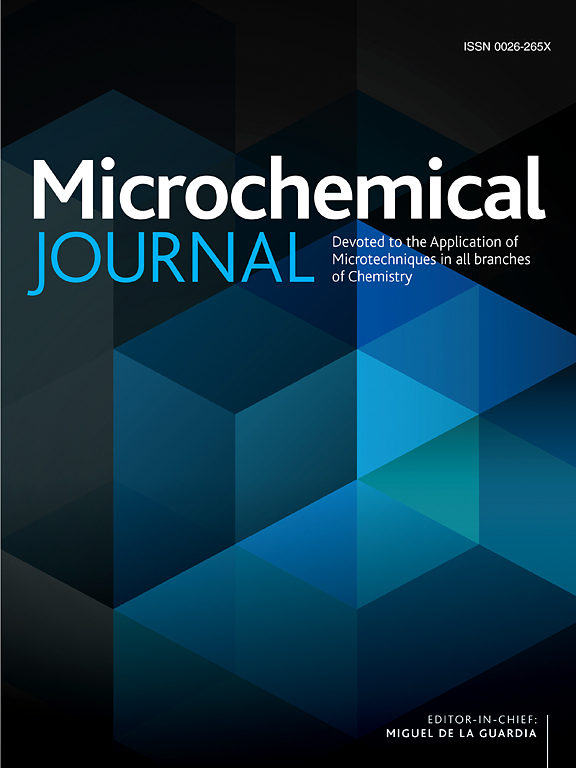Carbonised Typha tassel-modified enzymatic electrodes for ferrocene-mediated glucose biosensor and glucose/air biofuel cell applications
IF 4.9
2区 化学
Q1 CHEMISTRY, ANALYTICAL
引用次数: 0
Abstract
This study demonstrates the application of carbonised Typha tassel (CTT) in ferrocene-mediated enzymatic glucose biosensing and enzymatic biofuel cell (EnBFC) applications. Typha tassel was carbonised under an inert atmosphere to obtain conductive CTT which was then mixed with an effective electron transfer mediator, ferrocene (Fc) obtaining a redox-active electrode material. The successful immobilisation of the glucose oxidase (GOx) enzyme was performed on a CTT-Fc modified screen-printed electrode followed by a chitosan protective coating. The resulting enzymatic electrode was electrochemically characterised as a glucose biosensor with a working range of 0–10 mM and LOD and LOQ values of 0.19 mM and 0.56 mM, respectively. The developed glucose biosensor also showed good reproducibility and reusability with RSD% values of 6.68 % and 8.75 %, respectively. Furthermore, a real sample demonstration was performed using commercial jam samples with good recovery values. Finally, an EnBFC demonstration was performed using the enzymatic biosensor as an anode and a non-enzymatic cathode prepared using platinum black on gas diffusion carbon electrodes reaching a maximum power density of 3.6 µW cm−2. This study shows the promise of CTT as an alternative to conventional materials in enzymatic biosensor and bioelectronic applications as a suitable, cheap, and sustainable material.

用于二茂铁介导的葡萄糖生物传感器和葡萄糖/空气生物燃料电池应用的碳化菇缨修饰酶促电极
本研究展示了碳化的香菇流苏(CTT)在二茂铁介导的酶促葡萄糖生物传感和酶促生物燃料电池(EnBFC)中的应用。在惰性气氛下碳化,得到导电CTT,然后与有效的电子转移介质二茂铁(Fc)混合,得到氧化还原活性电极材料。葡萄糖氧化酶(GOx)在CTT-Fc修饰的丝网印刷电极上成功固定,然后涂上壳聚糖保护涂层。所得酶促电极经电化学表征为葡萄糖生物传感器,工作范围为0-10 mM, LOD和LOQ值分别为0.19 mM和0.56 mM。该传感器具有良好的重现性和可重复使用性,RSD%分别为6.68%和8.75%。此外,使用具有良好采收率的商业果酱样品进行了实际样品演示。最后,在气体扩散碳电极上使用酶促生物传感器作为阳极和铂黑制备的非酶促阴极进行了EnBFC演示,其最大功率密度为3.6 μ W cm - 2。这项研究表明,CTT作为一种合适、廉价和可持续的材料,有望在酶生物传感器和生物电子应用中替代传统材料。
本文章由计算机程序翻译,如有差异,请以英文原文为准。
求助全文
约1分钟内获得全文
求助全文
来源期刊

Microchemical Journal
化学-分析化学
CiteScore
8.70
自引率
8.30%
发文量
1131
审稿时长
1.9 months
期刊介绍:
The Microchemical Journal is a peer reviewed journal devoted to all aspects and phases of analytical chemistry and chemical analysis. The Microchemical Journal publishes articles which are at the forefront of modern analytical chemistry and cover innovations in the techniques to the finest possible limits. This includes fundamental aspects, instrumentation, new developments, innovative and novel methods and applications including environmental and clinical field.
Traditional classical analytical methods such as spectrophotometry and titrimetry as well as established instrumentation methods such as flame and graphite furnace atomic absorption spectrometry, gas chromatography, and modified glassy or carbon electrode electrochemical methods will be considered, provided they show significant improvements and novelty compared to the established methods.
 求助内容:
求助内容: 应助结果提醒方式:
应助结果提醒方式:


